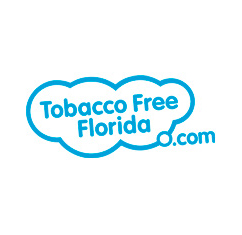It's a New Day in Public Health.
The Florida Department of Health works to protect, promote, and improve the health of all people in Florida through integrated state, county, and community efforts.
When It Comes to Tobacco, Smokeless Does Not Mean Harmless
February 11, 2013

FOR IMMEDIATE RELEASE
February 11, 2013
Contact: Communications Office
(850) 245-4111
or Naylet Aguayo
media@tobaccofreeflorida.com
(305) 572-2141
~ Tobacco Free Florida is Raising Awareness During Through With Chew Week ~
TALLAHASSEE—Tobacco products like chew, dip and snuff are not harmless. But because they’re smokeless, youth and adults may underestimate the serious health risks associated with these products. In fact, while cigarette use continues to decline, smokeless tobacco use has remained steady among Florida’s youth for more than a decade.
To help raise awareness about the dangers of smokeless tobacco, the Florida Department of Health’s Bureau of Tobacco Free Florida will observe Through With Chew Week from Feb.17–23.
“Some youth may mistakenly believe that when they start smoking or use any tobacco product, they are able to quit very easily," said State Surgeon General and Secretary of Health Dr. John Armstrong. “This type of addiction is very hard to break, and the health risks are extremely high for any tobacco product.”
Health Risks
Constant exposure to tobacco juices from these smokeless products can cause oral cancers, which can form within just five years of regular use,i and can cause cancer of the esophagus, pharynx, larynx, stomach and pancreas.ii Smokeless tobacco use can increase the risk of oral cancers by 80 percent and the risk of pancreatic and esophageal cancer by 60 percent, according to a 2008 study from the World Health Organization (WHO) International Agency for Research on Cancer.iii
Aside from the increased risk of cancer, using smokeless tobacco can increase the risk of heart attack and stroke.iv It can lead to other oral problems such as mouth sores, gum recession, tooth decay, and permanent discoloration of teeth.v
Smokeless tobacco use can also increase the risk of reproductive health problems such as reduced sperm count and abnormal sperm cells for men. Women who use smokeless tobacco may be at an increased risk of preeclampsia (a condition that may include high blood pressure, fluid retention, and swelling), premature birth, and low birth weight.vi
Addiction
Like cigarettes, smokeless tobacco products contain nicotine, a highly addictive and dangerous chemical. Smokeless tobacco users and cigarette smokers have comparable levels of nicotine in the blood, according to the National Cancer Institute.vii
Tobacco Free Florida has three ways to help smokeless tobacco users quit. Those who want to quit can double their chances at success by using one of these free and convenient quit services. For more information, visit www.tobaccofreeflorida.com.
For more information on smokeless tobacco, visit www.tobaccofreeflorida.com/smokelesstobacco.
ABOUT THROUGH WITH CHEW WEEK
This national annual health observance was established by the American Academy of Otolaryngology—Head and Neck Surgery as an educational campaign designed to prevent and reduce the use of smokeless tobacco. Through With Chew Week is now recognized by public health groups across the country. The week includes the Great American Spit Out on Thursday, Feb. 21, which encourages smokeless tobacco users to plan in advance to quit using smokeless tobacco that day, or to use the day to make a plan to quit.
ABOUT TOBACCO FREE FLORIDA
DOH’s Tobacco Free Florida campaign is a statewide cessation and prevention campaign funded by Florida’s tobacco settlement fund.
Tobacco users interested in quitting are encouraged to use one of the state’s three ways to quit. To learn about Tobacco Free Florida and the state’s free quit resources, visit www.tobaccofreeflorida.com or follow the campaign on Facebook at www.facebook.com/TobaccoFreeFlorida or Twitter at www.twitter.com/tobaccofreefla.
DOH works to protect, promote and improve the health of all people in Florida through integrated state, county and community efforts.
i The S.T.O.P. Guide (The Smokeless Tobacco Outreach and Prevention Guide): A Comprehensive Directory of Smokeless Tobacco Prevention and Cessation Resources. Applied Behavioral Science Press, 1997; Hatsukami, D & Severson, H, “Oral Spit Tobacco: Addiction, Prevention and Treatment,” Nicotine & Tobacco Research 1:21-44, 1999
ii National Cancer Institute, Centers for Disease Control and Prevention, Stockholm Centre of Public Health. Smokeless Tobacco Fact Sheets. Third International Conference on Smokeless Tobacco; Stockholm. September 22–25, 2002
iii Boffetta, P, et al., “Smokeless tobacco and cancer,” The Lancet 9:667-675, 2008
iv Boffetta, P, et al. “Use of smokeless tobacco and risk of myocardial infarction and stroke: systematic review with meta-analysis,” BMJ, 2009; 339 (aug18 2): b3060 DOI:10.1136/bmj.b3060
v Tomar, SL. “Chewing Tobacco Use and Dental Caries Among U.S. Men,” Journal of the American Dental Association, 1999, 130: 160.
vi World Health Organization. Smokeless Tobacco and Some Tobacco-Specific N-Nitrosamines. International Agency for Research on Cancer Monographs on the Evaluation of Carcinogenic Risks to Humans Vol. 89. Lyon, France: World Health Organization, 2007
vii National Cancer Institute. Smokeless Tobacco or Health: An International Perspective. Bethesda, MD: National Cancer Institute; 1992. Smoking and Tobacco Control Monograph 2.




Connect with DOH